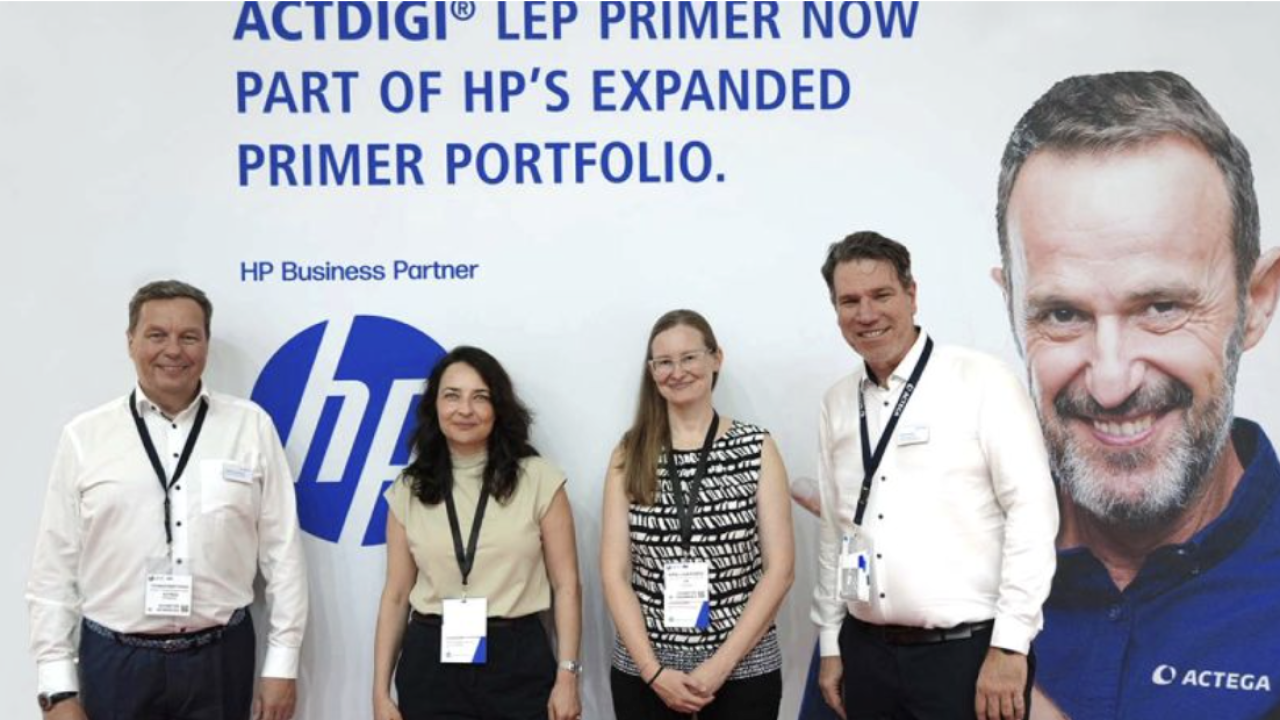Project showcases narrow web flexible package production
The use of narrow web technology in the production of flexible packaging is by no means a ‘bleeding edge’ development. Converters are embracing the opportunities in growing numbers, while the supply chain has an established portfolio of technologies available for those wanting to offer such capabilities to their customers.
Regular readers of L&L will know how the magazine has evolved to reflect this (see L&L editor James Quirk’s leader from issue 4, 2017), and visitors to recent Labelexpo shows around the world will similarly have seen first-hand how exhibitors have progressed from showing technologies for ‘labels’ and ‘packaging’ to those for ‘labels and packaging’.
Labelexpo Europe 2017 was the latest evidence of this (see L&L’s review on p98), including a project that brought together specialists in pre-press, material, press, inks and curing to push the market forward even further. Those dropping by the DuPont, Synthogra, Nilpeter, Flint or GEW stands at the show will have seen the outcome, with six designs of a bag for crisps (potato chips) on display, produced in short runs using a combination of their latest and greatest developments.
To make this a reality, the suppliers came together at Denmark’s Green Label earlier this summer, where the printing, inks, materials and UV curing were examined. In attendance were Lykke Trusbak and Anne Emborg from Nilpeter; Flint Group’s Niklas Olsson; Nanette Thomas, Christian Petersen and Helene Severin from Synthogra; and GEW’s Marcus Greenbrook.
Pre-press
This started with the creation of the printing plates, handled by Danish flexible packaging reprographic specialist hl-repro, using DuPont’s Cyrel DPR 45 plates with DigiFlow, a simple, inexpensive modification to existing DuPont exposure units that adds a chamber for the creation of a controlled atmosphere during the main exposure. As a result, flexographers can maintain an exact 1:1 reproduction of image elements on the plate for improved solid ink density, it is claimed.
Cyrel DPR is a robust digital plate, designed for printing on a variety of substrates and with different ink types – solvent- and water-based inks, and with limited compatibility with select UV inks.
Carsten Tychosen, hl-repro sales manager, was present to see his company’s work in action, with the plates mounted on polyurethane sleeves supplied by Synthogra using a JM Heaford plate mounting machine before loading onto the press, one of the first new-look Nilpeter FA flexo presses installed.
Printing
The newest FA machine in Nilpeter’s portfolio, launched at Labelexpo Europe 2017, is described as ‘the most versatile flexo press on the market’. It has been designed to accommodate printers’ ever-growing needs, according to the press manufacturer, with a shorter web path, redesigned print stations, tight register tolerance and ‘excellent printing results’ on multiple substrates. Both the 14in and 17in versions of the machine have a maximum printing speed of 200m/min, while value-adding units, and Application and Automation Packages can be specified, according to application needs and budget. Based on Nilpeter’s Clean-Hand design approach, the new FA model ensures clean hands during press operation, with a minimum of hands-on press interaction; all data is saved, jobs are easily recalled and the press will auto register. The new press has further been built around the needs of modern press operators, with an intuitive user interface and fully mobile print controls.
‘This press has been designed to be as simple to use as possible,’ says Lykke Trusbak, Nilpeter technology center manager and representing the company as the first jobs began to run off the press. ‘At its heart, it is a simple – yet sophisticated – machine with a high degree of available automation to make production as efficient as possible. The platform is flexible, and with the various add-ons and packages available it can quickly be upgraded to a high-end system in line with the users’ needs.’
The Green Label production hall features flexo and digital printing technology, finishing and converting machinery, alongside which the new press sits. When L&L visited Green Label’s production facility outside of Aarhus in August, the press had only recently been installed, with owner Claus Grønning and his team still learning the ins and outs of their new eight print station machine. Only printing using five colors at this time, quick changeovers were already in evidence. Grønning was already full of praise for the new press on his company’s shop floor, with his initial feedback being that it is, ‘easy-to-use, efficient and productive’.
Consumables
Supported by Nilpeter technician Steffen Vahlkvist, the press was running a metallized PET/ PE B from Synthogra, printed using Flint’s Flexocure Ancora 50 low migration inkset to print CMYK+W, cured using GEW E2C UV lamps positioned after each print station, and then laminated with a BOPP film, also from Synthogra’s product portfolio.
Flexocure Ancora 50 is one of Flint Group’s latest developments, and is suitable for printing labels and certain flexible packaging applications where specific demands for low migration are required. It can be used in all narrow and mid web flexographic print units where the ink is cured using UV. A white ink, also from the Flexocure Ancora series, was laid down in the first print station.
GEW’s E2C is a low energy UV curing system for narrow web presses, featuring the Rhino electronic power supply, and enabling color process printing at full production speed with as little power as 90W/cm. E2C UV curing systems can be used with a wide range of heat-sensitive materials with no heat transfer to the machine or substrate at stand-by through the use of actively air-cooled shutter technology.
Synthogra has been working hard for a number of years to deliver various materials, especially packaging films, in orders suited to short-run production. These are targeted at both narrow and wide web converters, with its offering to narrow web converters intended to deliver business opportunities as a supplement to conventional label printing and converting. For example, Synthogra’s single layer flexible films, and multilayer flexible films for flow packaging, sachets and lidding films are optimized for printing on narrow web machines using flexo, UV flexo and digital.
Synthogra’s recently refurbished facility close to Copenhagen holds stocks of upwards of 700 varieties, slit into widths and lengths as required by customers, and delivered just-in-time. Two Jurmet slitting machines take center stage, with Thomas discussing the possibility of adding a laminating unit in the near future. Synthogra currently does no in-house production of its materials, although the company is involved in developing a range of constructions intended for diverse applications. Synthogra owns recipes of many of its films that are ‘very unique’ and modified to the narrow web industry.
After printing, both gloss and matte overlamination films from Synthogra were applied to the same job for the partners present to assess the output using both finishes. Further, Flint Group has taken samples for migration testing, and although the results were not available at the time of going to press, Olsson predicted that the results would show how the combination of the correctly specified material, low migration inks, efficient UV curing and lamination make successful production of flexible packaging using narrow web technology a genuine opportunity.
‘We are writing history’
‘We think the time is now for narrow web converters to enter the flexible packaging market,’ states Olsson. ‘The technologies have been around for a number of years, but evolutions in the supply chain have brought the next-generation of products to market, which when coupled with growing interest from converters and their customers in efficient short-run packaging production, makes it the right time.’
For the other suppliers involved, their eight-month collaboration has been conducted to make clear to the market that there are genuine technologies available, with the whole supply chain able to unite to help address any concerns and overcome any obstacles in the adoption of narrow web flexible packaging.
‘There has never been a gathering like this, on this scale, so it shows how the supply chain is ready, willing and able to support those looking to take the step into flexible packaging, as well as those that already have with their next steps,’ says Thomas.
‘We wanted to hold the customers hand from the beginning to the end. From idea to plates, ink, drying, printing and testing, until the product is packed and ready. We did it.’
Olsson adds that another way the market might develop is with wide web manufacturer’s investing in narrow web machines to extend their offering. As an example, Ivory Coast flexible packaging printer Socipack has invested in a Nilpeter FA-6* flexo press to meet increasing market demand for adhesives labels, sleeves and wrap-around labels.
‘The process is embedded in the narrow web market, giving label companies the tools to produce short runs of flexible packaging,’ concludes Olsson.
Stay up to date
Subscribe to the free Label News newsletter and receive the latest content every week. We'll never share your email address.


